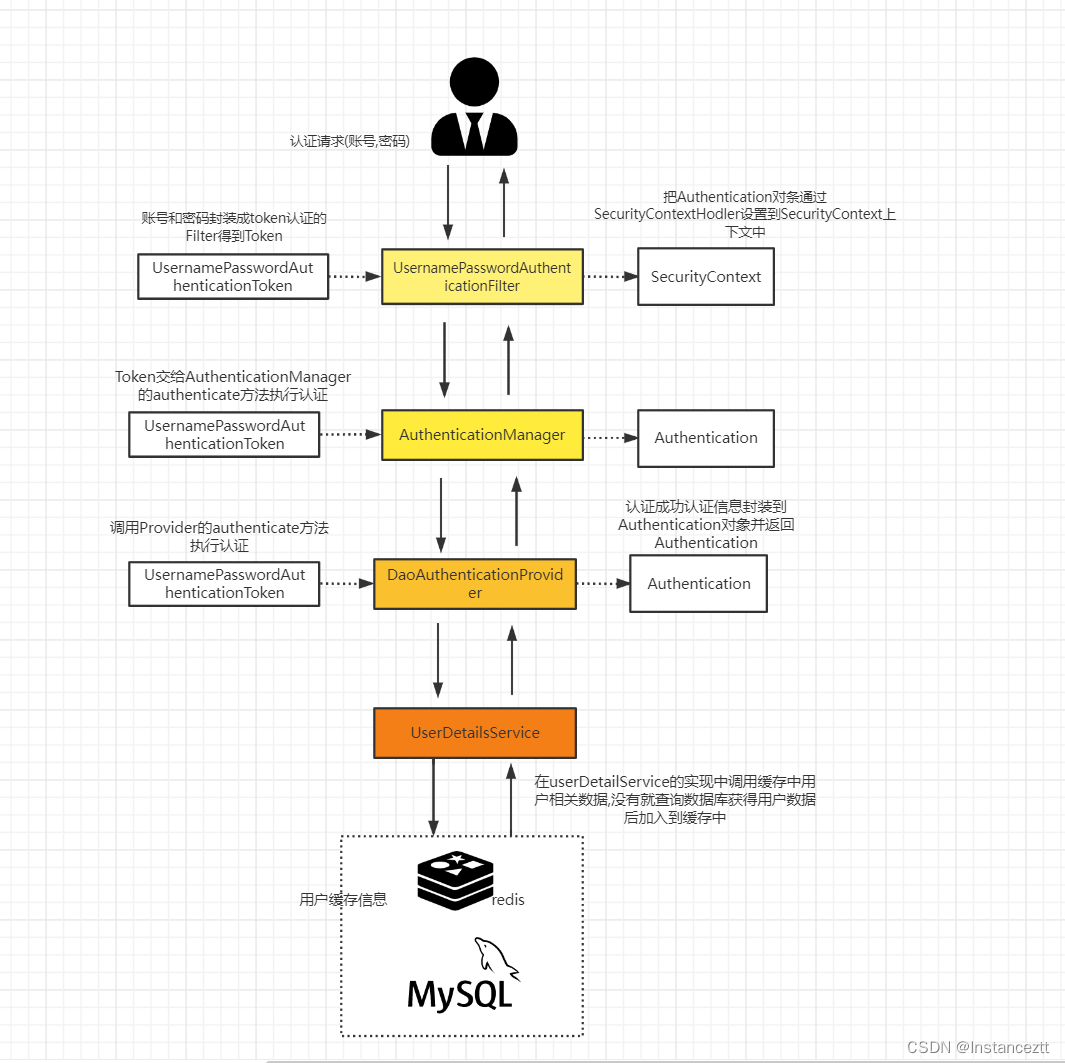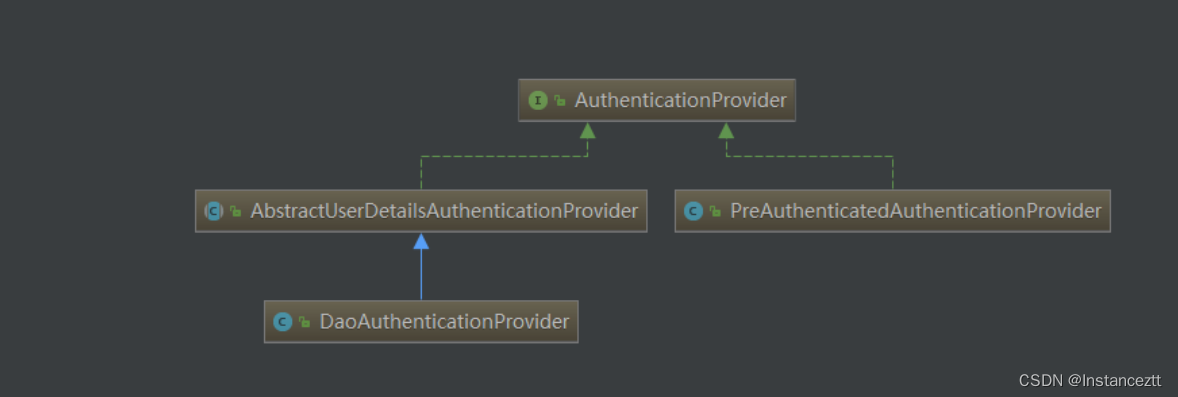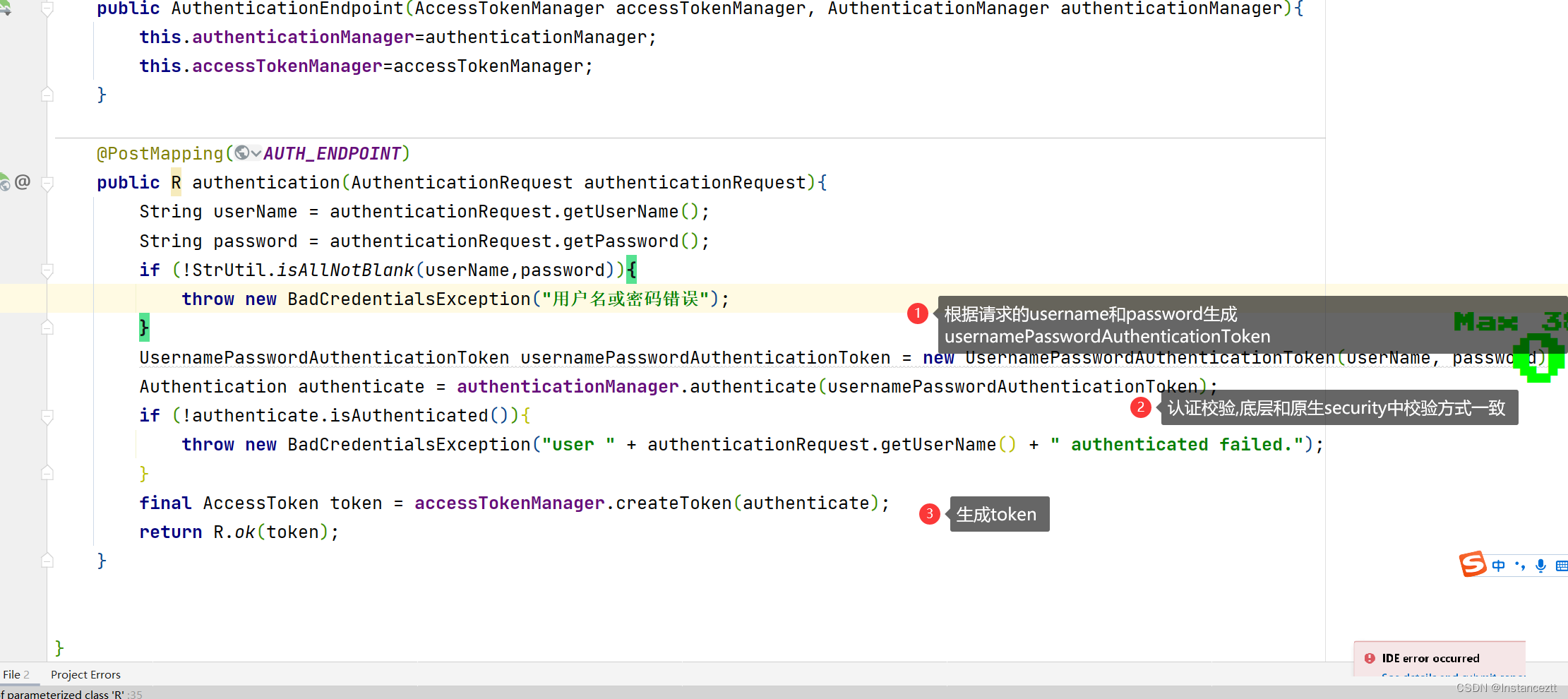一 引言
通过上篇文章分析我们知道了通过FilterChainProxy我们管理许多的过滤器链,其中UsernamePasswordAuthenticationFilter默认拦截“/login”登录请求,处理表单提交的登录认证,将请求中的认证信息包括username,password等封装成UsernamePasswordAuthenticationToken,然后调用AuthenticationManager的认证方法进行认证,其局具体流程如下:

- 请求过来会被过滤器链中的
UsernamePasswordAuthenticationFilter拦截到,请求中的用户名和密码被封装成UsernamePasswordAuthenticationToken(Authentication的实现类) - 过滤器将UsernamePasswordAuthenticationToken提交给认证管理器(
AuthenticationManager)进行认证 - AuthenticationManager委托
AuthenticationProvider(DaoAuthenticationProvider)进行认证,AuthenticationProvider通过调用UserDetailsService获取到数据库或缓存中存储的用户信息(UserDetails),然后调用passwordEncoder密码编码器对UsernamePasswordAuthenticationToken中的密码和UserDetails中的密码进行比较 - AuthenticationProvider认证成功后封装
Authentication并设置好用户的信息(用户名,密码,权限等)返回 - Authentication被返回到UsernamePasswordAuthenticationFilter,通过调用
SecurityContextHolder工具把Authentication封装成SecurityContext中存储起来。然后UsernamePasswordAuthenticationFilter调用AuthenticationSuccessHandler.onAuthenticationSuccess做认证成功后续处理操作 - 最后
SecurityContextPersistenceFilter通过SecurityContextHolder.getContext()获取到SecurityContext对象然后调用SecurityContextRepository将SecurityContext存储起来,然后调用SecurityContextHolder.clearContext方法清理SecurityContext。
注意:SecurityContext是一个和当前线程绑定的工具,在代码的任何地方都可以通过SecurityContextHolder.getContext()获取到登陆信息。
二 ProviderManager分析
在Spring Security中,所有的认证服务,均通过ProviderManager认证管理中心进行认证。通过分析ProviderManager,可以理解Spring Security认证的细节。也是整个流程中最核心的环节之一。
2.1 ProviderManager 的类结构
ProviderManager 继承实现AuthenticationManager接口。
public class ProviderManager implements AuthenticationManager, MessageSourceAware,
InitializingBean {
.....
}
AuthenticationManager 接口只有一个方法:Authentication authenticate(Authentication authentication)
throws AuthenticationException,该方法传入一个Authentication 的实例,认证成功返回的是 Authentication 的一个具体实例。
public interface AuthenticationManager {
Authentication authenticate(Authentication authentication)
throws AuthenticationException;
}
Authentication 接口描述:
public interface Authentication extends Principal, Serializable {
// 返回当前用户的权限列表
Collection<? extends GrantedAuthority> getAuthorities();
// 获取当前认证的密码
Object getCredentials();
//存储有关身份验证请求的其他详细信息。 这些可能是IP地址,证书序列号等
Object getDetails();
//获取当前用户名
Object getPrincipal();
// 获取是否已经认证
boolean isAuthenticated();
// 设置是否通过认证
void setAuthenticated(boolean isAuthenticated) throws IllegalArgumentException;
}
2.2 AuthenticationManager 接口实现类
AuthenticationManager 部分实现类,在当前的用户名密码认证的过程中,主要的核心类是:ProviderManager

2.3 Authentication 接口实现类
列举出Authentication 部分实现核心类,在用户名密码认证过程中,主要使用的核心类是:UsernamePasswordAuthenticationToken。

2.3.ProviderManager 类的成员变量和代码
public class ProviderManager implements AuthenticationManager, MessageSourceAware,
InitializingBean {
// 认证提供者列表。认证提供者主要根据传入的不同的 Authentication 决定使用哪种认证方式
// providers 集合在项目启动的时候会被初始化进去。主要初始化的提供者有两个:
// AnonymousAuthenticationProvider 和 DaoAuthenticationProvider
private List<AuthenticationProvider> providers = Collections.emptyList();
// 上一级认证管理者,一般情况下用不到
private AuthenticationManager parent;
// 构造函数初始化
public ProviderManager(List<AuthenticationProvider> providers,
AuthenticationManager parent) {
Assert.notNull(providers, "providers list cannot be null");
this.providers = providers;
this.parent = parent;
checkState();
}
// 通过传入不同的 authentication ,决定使用哪种认证方式去认证当前用户
// 每个authentication 对应着一个认证策略
public Authentication authenticate(Authentication authentication)
throws AuthenticationException {
Class<? extends Authentication> toTest = authentication.getClass();
AuthenticationException lastException = null;
Authentication result = null;
boolean debug = logger.isDebugEnabled();
// 遍历当前集合,找到和authentication 匹配的认证方式。
for (AuthenticationProvider provider : getProviders()) {
// 判断是否支持当前认证方式
if (!provider.supports(toTest)) {
continue;
}
if (debug) {
logger.debug("Authentication attempt using "
+ provider.getClass().getName());
}
try {
// 调用当前认证方式的具体实现类
result = provider.authenticate(authentication);
if (result != null) {
copyDetails(authentication, result);
break;
}
}
catch (AccountStatusException e) {
prepareException(e, authentication);
// SEC-546: Avoid polling additional providers if auth failure is due to
// invalid account status
throw e;
}
catch (InternalAuthenticationServiceException e) {
prepareException(e, authentication);
throw e;
}
catch (AuthenticationException e) {
lastException = e;
}
}
// 如果当前认证返回结果为空,则调用类初始化的上一级认证方式
if (result == null && parent != null) {
// Allow the parent to try.
try {
result = parent.authenticate(authentication);
}
catch (ProviderNotFoundException e) {
// ignore as we will throw below if no other exception occurred prior to
// calling parent and the parent
// may throw ProviderNotFound even though a provider in the child already
// handled the request
}
catch (AuthenticationException e) {
lastException = e;
}
}
if (result != null) {
if (eraseCredentialsAfterAuthentication
&& (result instanceof CredentialsContainer)) {
// Authentication is complete. Remove credentials and other secret data
// from authentication
// 对当前认证通过的authentication 信息进行脱敏处理
((CredentialsContainer) result).eraseCredentials();
}
eventPublisher.publishAuthenticationSuccess(result);
//返回当前的认证结果
return result;
}
if (lastException == null) {
lastException = new ProviderNotFoundException(messages.getMessage(
"ProviderManager.providerNotFound",
new Object[] {
toTest.getName() },
"No AuthenticationProvider found for {0}"));
}
prepareException(lastException, authentication);
throw lastException;
}
}
ProviderManager 认证管理中心,相当于一个策略模板,根据传入的认证信息,选择不同的认证处理器进行处理
2.4.AuthenticationProvider 接口详解
针对不同认证信息,AuthenticationProvider 提供了不同的对应策略。
public interface AuthenticationProvider {
// 具体的认证细节
Authentication authenticate(Authentication authentication)
throws AuthenticationException;
// 判断是否支持当前认证
boolean supports(Class<?> authentication);
}
AuthenticationProvider 核心实现类

在密码认证的过程中,其核心的认证类是:AbstractUserDetailsAuthenticationProvider 和DaoAuthenticationProvider。这里使用了设计模式中的模板方法进行实现。
三 SpringSecurity中认证源码分析
SecurityContextPersistenceFilter
这个filter是整个filter链的入口和出口,请求开始会从SecurityContextRepository中 获取SecurityContext对象并设置给SecurityContextHolder。在请求完成后将
SecurityContextHolder持有的SecurityContext再保存到配置好的
DecurityContextRepository中,同时清除SecurityContextHolder中的SecurityContext
总结一下:SecurityContextPersistenceFilter它的作用就是请求来的时候将包含了认证授权信息的SecurityContext对象从SecurityContextRepository中取出交给SecurityContextHolder工具类,方便我们通过SecurityContextHolder获取SecurityContext从而获取到认证授权信息,请求走的时候又把SecurityContextHolder清空,源码如下:
public class SecurityContextPersistenceFilter extends GenericFilterBean {
...省略...
public void doFilter(ServletRequest req, ServletResponse res, FilterChain chain) throws IOException, ServletException {
...省略部分代码...
HttpRequestResponseHolder holder = new HttpRequestResponseHolder(request,
response);
//从SecurityContextRepository获取到SecurityContext
SecurityContext contextBeforeChainExecution = repo.loadContext(holder);
try {
//把 securityContext设置到SecurityContextHolder,如果没认证通过,这个SecurtyContext就是空的
SecurityContextHolder.setContext(contextBeforeChainExecution);
//调用后面的filter,比如掉用usernamepasswordAuthenticationFilter实现认证
chain.doFilter(holder.getRequest(), holder.getResponse());
}
finally {
//如果认证通过了,这里可以从SecurityContextHolder.getContext();中获取到SecurityContext
SecurityContext contextAfterChainExecution = SecurityContextHolder
.getContext();
// Crucial removal of SecurityContextHolder contents - do this before anything
// else.
//删除SecurityContextHolder中的SecurityContext
SecurityContextHolder.clearContext();
//把SecurityContext 存储到SecurityContextRepository
repo.saveContext(contextAfterChainExecution, holder.getRequest(),
holder.getResponse());
request.removeAttribute(FILTER_APPLIED);
if (debug) {
logger.debug("SecurityContextHolder now cleared, as request processing completed");
}
}
...省略...
UsernamePasswordAuthenticationFilter
它的重用是,拦截“/login”登录请求,处理表单提交的登录认证,将请求中的认证信息包括username,password等封装成UsernamePasswordAuthenticationToken,然后调用
AuthenticationManager的认证方法进行认证。
public class UsernamePasswordAuthenticationFilter extends
AbstractAuthenticationProcessingFilter {
// ~ Static fields/initializers
// =====================================================================================
//从登录请求中获取参数:username,password的名字
public static final String SPRING_SECURITY_FORM_USERNAME_KEY = "username";
public static final String SPRING_SECURITY_FORM_PASSWORD_KEY = "password";
private String usernameParameter = SPRING_SECURITY_FORM_USERNAME_KEY;
private String passwordParameter = SPRING_SECURITY_FORM_PASSWORD_KEY;
//默认支持POST登录
private boolean postOnly = true;
//默认拦截/login请求,Post方式
public UsernamePasswordAuthenticationFilter() {
super(new AntPathRequestMatcher("/login", "POST"));
}
// ~ Methods
// ========================================================================================================
public Authentication attemptAuthentication(HttpServletRequest request,
HttpServletResponse response) throws AuthenticationException {
//判断请求是否是POST
if (postOnly && !request.getMethod().equals("POST")) {
throw new AuthenticationServiceException(
"Authentication method not supported: " + request.getMethod());
}
//获取到用户名和密码
String username = obtainUsername(request);
String password = obtainPassword(request);
if (username == null) {
username = "";
}
if (password == null) {
password = "";
}
username = username.trim();
//用户名和密码封装Token
UsernamePasswordAuthenticationToken authRequest = new UsernamePasswordAuthenticationToken(
username, password);
//设置details属性
// Allow subclasses to set the "details" property
setDetails(request, authRequest);
//调用AuthenticationManager().authenticate进行认证,参数就是Token对象
return this.getAuthenticationManager().authenticate(authRequest);
}
AuthenticationManager
请求通过UsernamePasswordAuthenticationFilter调用AuthenticationManager,默认走的实现类是ProviderManager,它会找到能支持当前认证的AuthenticationProvider实现类调用器authenticate方法执行认证,认证成功后会清除密码,然后抛出AuthenticationSuccessEvent事件
public class ProviderManager implements AuthenticationManager, MessageSourceAware,
InitializingBean {
...省略...
//这里authentication 是封装了登录请求的认证参数,
//即:UsernamePasswordAuthenticationFilter传入的Token对象
public Authentication authenticate(Authentication authentication)
throws AuthenticationException {
Class<? extends Authentication> toTest = authentication.getClass();
AuthenticationException lastException = null;
AuthenticationException parentException = null;
Authentication result = null;
Authentication parentResult = null;
boolean debug = logger.isDebugEnabled();
//找到所有的AuthenticationProvider ,选择合适的进行认证
for (AuthenticationProvider provider : getProviders()) {
//是否支持当前认证
if (!provider.supports(toTest)) {
continue;
}
if (debug) {
logger.debug("Authentication attempt using "
+ provider.getClass().getName());
}
try {
//调用provider执行认证
result = provider.authenticate(authentication);
if (result != null) {
copyDetails(authentication, result);
break;
}
}
...省略...
}
...省略...
//result就是Authentication ,使用的实现类依然是UsernamepasswordAuthenticationToken,
//封装了认证成功后的用户的认证信息和授权信息
if (result != null) {
if (eraseCredentialsAfterAuthentication
&& (result instanceof CredentialsContainer)) {
// Authentication is complete. Remove credentials and other secret data
// from authentication
//这里在擦除登录密码
((CredentialsContainer) result).eraseCredentials();
}
// If the parent AuthenticationManager was attempted and successful than it will publish an AuthenticationSuccessEvent
// This check prevents a duplicate AuthenticationSuccessEvent if the parent AuthenticationManager already published it
if (parentResult == null) {
//发布事件
eventPublisher.publishAuthenticationSuccess(result);
}
return result;
}
DaoAuthenticationProvider
请求到达AuthenticationProvider,默认实现是DaoAuthenticationProvider,它的作用是根据传入的Token中的username调用UserDetailService加载数据库中的认证授权信息(UserDetails),然后使用PasswordEncoder对比用户登录密码是否正确
public class DaoAuthenticationProvider extends AbstractUserDetailsAuthenticationProvider {
//密码编码器
private PasswordEncoder passwordEncoder;
//UserDetailsService ,根据用户名加载UserDetails对象,从数据库加载的认证授权信息
private UserDetailsService userDetailsService;
//认证检查方法
protected void additionalAuthenticationChecks(UserDetails userDetails,
UsernamePasswordAuthenticationToken authentication)
throws AuthenticationException {
if (authentication.getCredentials() == null) {
logger.debug("Authentication failed: no credentials provided");
throw new BadCredentialsException(messages.getMessage(
"AbstractUserDetailsAuthenticationProvider.badCredentials",
"Bad credentials"));
}
//获取密码
String presentedPassword = authentication.getCredentials().toString();
//通过passwordEncoder比较密码,presentedPassword是用户传入的密码,userDetails.getPassword()是从数据库加载到的密码
//passwordEncoder编码器不一样比较密码的方式也不一样
if (!passwordEncoder.matches(presentedPassword, userDetails.getPassword())) {
logger.debug("Authentication failed: password does not match stored value");
throw new BadCredentialsException(messages.getMessage(
"AbstractUserDetailsAuthenticationProvider.badCredentials",
"Bad credentials"));
}
}
//检索用户,参数为用户名和Token对象
protected final UserDetails retrieveUser(String username,
UsernamePasswordAuthenticationToken authentication)
throws AuthenticationException {
prepareTimingAttackProtection();
try {
//调用UserDetailsService的loadUserByUsername方法,
//根据用户名检索数据库中的用户,封装成UserDetails
UserDetails loadedUser = this.getUserDetailsService().loadUserByUsername(username);
if (loadedUser == null) {
throw new InternalAuthenticationServiceException(
"UserDetailsService returned null, which is an interface contract violation");
}
return loadedUser;
}
catch (UsernameNotFoundException ex) {
mitigateAgainstTimingAttack(authentication);
throw ex;
}
catch (InternalAuthenticationServiceException ex) {
throw ex;
}
catch (Exception ex) {
throw new InternalAuthenticationServiceException(ex.getMessage(), ex);
}
}
//创建认证成功的认证对象Authentication,使用的实现是UsernamepasswordAuthenticationToken,
//封装了认证成功后的认证信息和授权信息,以及账户的状态等
@Override
protected Authentication createSuccessAuthentication(Object principal,
Authentication authentication, UserDetails user) {
boolean upgradeEncoding = this.userDetailsPasswordService != null
&& this.passwordEncoder.upgradeEncoding(user.getPassword());
if (upgradeEncoding) {
String presentedPassword = authentication.getCredentials().toString();
String newPassword = this.passwordEncoder.encode(presentedPassword);
user = this.userDetailsPasswordService.updatePassword(user, newPassword);
}
return super.createSuccessAuthentication(principal, authentication, user);
}
...省略...
这里提供了三个方法
- additionalAuthenticationChecks:通过passwordEncoder比对密码
- retrieveUser:根据用户名调用UserDetailsService加载用户认证授权信息
- createSuccessAuthentication:登录成功,创建认证对象Authentication
然而你发现 DaoAuthenticationProvider 中并没有authenticate认证方法,真正的认证逻辑是通过父类AbstractUserDetailsAuthenticationProvider.authenticate方法完成的
public abstract class AbstractUserDetailsAuthenticationProvider implements
AuthenticationProvider, InitializingBean, MessageSourceAware {
//认证逻辑
public Authentication authenticate(Authentication authentication)
throws AuthenticationException {
//得到传入的用户名
String username = (authentication.getPrincipal() == null) ? "NONE_PROVIDED"
: authentication.getName();
//从缓存中得到UserDetails
boolean cacheWasUsed = true;
UserDetails user = this.userCache.getUserFromCache(username);
if (user == null) {
cacheWasUsed = false;
try {
//检索用户,底层会调用UserDetailsService加载数据库中的UserDetails对象,保护认证信息和授权信息
user = retrieveUser(username,
(UsernamePasswordAuthenticationToken) authentication);
}
catch (UsernameNotFoundException notFound) {
...省略...
}
try {
//前置检查,主要检查账户是否锁定,账户是否过期等
preAuthenticationChecks.check(user);
//比对密码在这个方法里面比对的
additionalAuthenticationChecks(user,
(UsernamePasswordAuthenticationToken) authentication);
}
catch (AuthenticationException exception) {
...省略...
}
//后置检查
postAuthenticationChecks.check(user);
if (!cacheWasUsed) {
//设置UserDetails缓存
this.userCache.putUserInCache(user);
}
Object principalToReturn = user;
if (forcePrincipalAsString) {
principalToReturn = user.getUsername();
}
//认证成功,创建Auhentication认证对象
return createSuccessAuthentication(principalToReturn, authentication, user);
}
UsernamePasswordAuthenticationFilter
认证成功,请求会重新回到UsernamePasswordAuthenticationFilter,然后会通过其父类AbstractAuthenticationProcessingFilter.successfulAuthentication方法将认证对象封装成SecurityContext设置到SecurityContextHolder中
protected void successfulAuthentication(HttpServletRequest request,
HttpServletResponse response, FilterChain chain, Authentication authResult)
throws IOException, ServletException {
if (logger.isDebugEnabled()) {
logger.debug("Authentication success. Updating SecurityContextHolder to contain: "
+ authResult);
}
//认证成功,吧Authentication 设置到SecurityContextHolder
SecurityContextHolder.getContext().setAuthentication(authResult);
//处理记住我业务逻辑
rememberMeServices.loginSuccess(request, response, authResult);
// Fire event
if (this.eventPublisher != null) {
eventPublisher.publishEvent(new InteractiveAuthenticationSuccessEvent(
authResult, this.getClass()));
}
//重定向登录成功地址
successHandler.onAuthenticationSuccess(request, response, authResult);
}
然后后续请求又会回到SecurityContextPersistenceFilter,它就可以从SecurityContextHolder获取到SecurityContext持久到SecurityContextRepository(默认实现是HttpSessionSecurityContextRepository基于Session存储)
四 案列说明
在笔者基于springsecurity和jwt实现的单体项目token认证中笔者并没有使用默认的授权模式 而是对外提供一个接口,在接口中通过AuthManager来进行用户校验,校验成功后生成jwt


到此整个认证过程就完成了